At your service
19 March 2014 | Extracts, Non-fiction
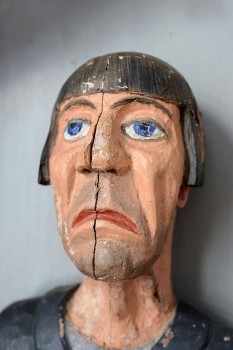
Melancholy man: detail of the almsman in Pomarkku, carved by Artturi Kaseva in the 1920s. Photo: Aki Paavola
Old men carved of wood have stood outside churches since the 17th century, begging for money to be given to the poor and the sick of the parish. These almsmen, or men-at-alms, mostly represented a disabled soldier; the tradition is not known elsewhere. Some 40 of the still surviving almsmen (there is one almswoman) were assembled for an exhibition in Kerimäki – in the world’s largest Christian wooden church – in summer 2013. The surviving specimens were hunted down and photographed by Aki Paavola for the book Vaivaisukkojen paluu (‘The return of the almsmen’). Otso Kantokorpi asks in the title of his introduction: are men-at-alms pioneers of ITE (from the words itse tehty elämä, ‘self-made life’; the English-language term is ‘outsider art’) or a disappearing folk tradition?
Many a church or belfry wall, particularly in Ostrobothnia, has been decorated – and is often still decorated – with a wooden human figure. Often they stand beneath a decorative canopy, sometimes accompanied by an encouraging phrase: He that hath pity upon the poor lendeth unto the LORD. They have been called men-at-alms or boys-at-alms.
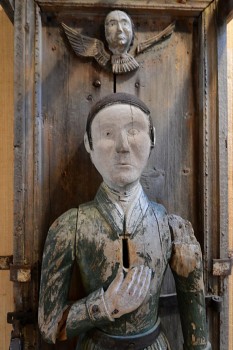
Wear and tear: the almsman of Veteli, probably from the 19th century, now resides in a museum. Photo: Aki Paavola
Most men-at-arms are from the 19th century, but the oldest of them may be from as long ago as the late 17th century. Their stylistic roots have not been closely traced. Some of the oldest examples are reminiscent of church woodcarvings; some of the later ones are clearly linked with the ship-building and woodcarving tradition of the Ostrobothnian coast. Ships’ figureheads, after all, may have their own significance.
Many of the figures are one-legged veterans of the war of 1808–9, and many of them stand close to the battlefields of Ostrobothnia [Finland was part of Sweden, and the war with Russia was fought in the western parts of what is now Finland].
One could even argue that the examples of men-at-arms found in Sweden (less than ten of them, none of them an invalid) originate with the same war, and were inspired by craftsmen who had migrated across the Gulf of Bothnia. This tradition is unknown in the rest of the world, so this is a globally unique phenomenon.
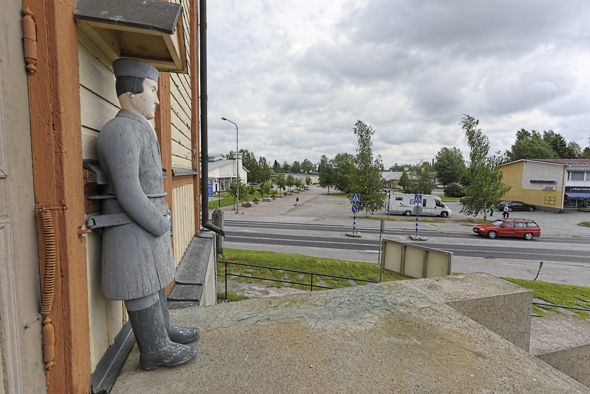
Still working: this almsman, dating probably from the first half of the 19th century,
stands outside the belfry in Kannus. Photo: Aki Paavola
In Finland, there have been about 180 recorded examples of men-at-arms, of which around 145 survive – and one woman. Some have been lost, some have been decayed and disposed of. Many have been damaged more than once by robbers – one was taken from a church wall in Rautio in the autumn of 2012! This sad case had a happy ending, however, when the man was found, last May, abandoned by a remote forest road. It had become rather waterlogged over the winter, but will after restoration be able to continue its work.
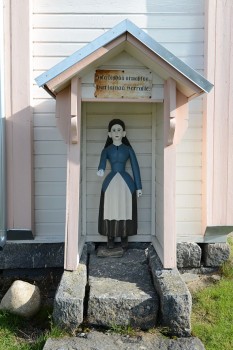
The lady of Soini: made by Matti Taipale in 1854 for five silver roubles, she is the only female almsperson. Photo: Aki Paavola
For the contemporary viewer, it is a little difficult to enter the aesthetic world of the men-at-arms. Unlike more valuable church art, the men have stood outdoors in all weather. This has meant that the figures have constantly been mended and painted, which has also sometimes been fatefully neglected. Protruding parts – extended hands, even noses – have been lost and sometimes replaced with new ones. Repainting has not always followed the original, and the colours of clothes has sometimes changed completely….
Assessing the vision of the original master and it success is, through these historical twists and turns, often difficult. But ordinary people’s relationship with them, from their earliest youth, has always been aesthetic – there has been pride in the skill of local artisans.
Men-at-alms have been a kind of utilitarian art which has been expected to beome worn, need mending and finally become garbage. In many parishes there has been more than one man-at-alms at work: a new one has been made when the old one has clearly completed its turn of duty…
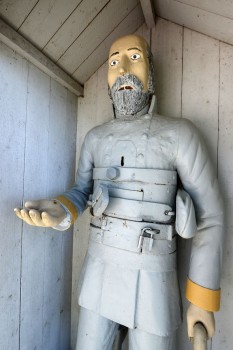
A Carolean soldier: this 17th-century war invalid stands in Vöyri, carved by Mårten Lassus in mid-19th century. Photo: Aki Paavola
Even though men-at-alms have been valued since the early 20th century, they have not yet been recognised as objects of study by traditional art history; they have remained long and stubbornly on the margins.
With the help of archives, men-at-alms can be dated more accurately, and even the makers can be identified with greater certainty. There is a need for basic scholarship, not least because of the natural continuum between the men and the theory and practice of outsider art.
The tradition clearly has its own strong connection to the history of folk creativity: it can hardly be wrong to suppose that many more recent folk artists may have gained inspiration directly from the world of the men-at-arms, since so many people report that the figures have been engraved on their memories of childhood and youth.
Translated by Hildi Hawkins
Vaivaisukkojen paluu
[The return of the almsmen]
Toim. [Ed. by] Otso Kantokorpi
Helsinki: Maahenki, 2013
ISBN 978-952-5870-88-6
See Kerimäki Church
Tags: art, cultural history, religion
No comments for this entry yet
